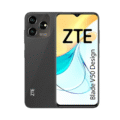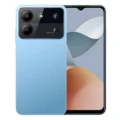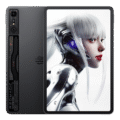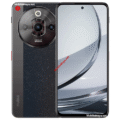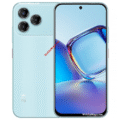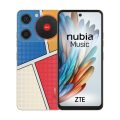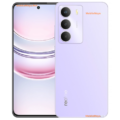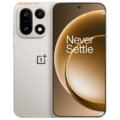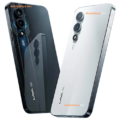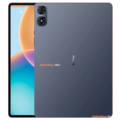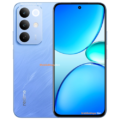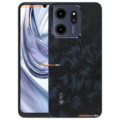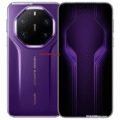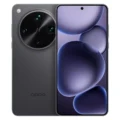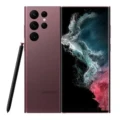Price List: Under Tk.5,000 | Tk.5001-10000 | Tk.10001-15000 | Tk.15001-20000 | Tk.20001-30000 | Tk.30001-40000 | More Mobiles
- Home
- All Mobile
- ZTE
- ZTE Blade A53
ZTE Blade A53
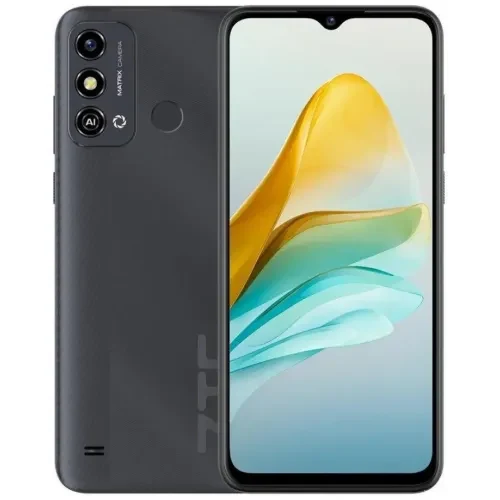


Specifications
Price in Bangladesh
| Official | 2GB 32GB ৳7,999 |
General
| Device Type | Smartphone |
| Announced | May, 2025 |
| Released | May, 2025 |
| Status | Available |
Hardware & Software
| Operating System OS => Every computer system run on a base software called Operating System (OS). Operating System controls all basic operations of the computer (such as smartphone, PDAs, tablet computers and other handheld devices). The Operating System allows the user to install and run third party applications (apps), apps are used to add new functionality to the device. | Android |
| OS Version | v12 |
| Chipset Chipset is a group of integrated circuits designed to perform one or a more dedicated functions, often with real time computing constraints, Popular smartphones are equipped with more advanced embedded chipsets that can do many different tasks depending on their programming. | Unisoc SC9863A1 (28 nm) |
| CPU CPU (Central Processing Unit) mostly known as processors, CPU processes instructions in order to carry out certain functions that make your device operate properly. Processors are often described as the brain of computers, smartphones and tablets, Smartphones and tablets rely on processors to carry out their every task, Processors are an incredibly important factor in selecting any type of computing device, including your smartphone. | Octa-core (4x1.6 GHz Cortex-A55 & 4x1.2 GHz Cortex-A55) |
| GPU GPU (Graphics Processing Unit) is a single-chip processor designed to rapidly manipulate and alter memory to accelerate the creation of images in a frame buffer intended for output to a display, This includes things such as lighting effects, object transformations, and 3D motion. | IMG8322 |
| RAM (Memory) RAM (Random Access Memory) is a type of computer memory that can be accessed randomly, any byte of memory can be accessed without touching the preceding bytes that allows information to be stored and accessed quickly from random locations. RAM is the most common type of memory found in computer systems, smartphones, tablets and other electronic devices. | 2 GB |
Design
| Dimensions | 165.7 x 76.4 x 9.1 mm (6.52 x 3.01 x 0.36 in) |
| Weight | - |
| Colors |
Gray, Blue, Green |
Display
| Display Type Display Technology => A number of display technologies and types used in mobile phones => TFT (Thin Film Transistor), IPS (In-Place Switching), OLED (Organic Light Emitting Diode), AMOLED (Active-Matrix Organic Light-Emitting Diode), Super AMOLED (an even advanced version of AMOLED), Resistive Touchscreen (Resistive touchscreens contain two layer of conductive material with a very small gap between them which acts as a resistance), Capacitive Touchsceen (Capacitive touchscreen technology consists of a layer of glass coated with a transparent conductor) | IPS LCD |
| Size | 6.52 inches, 102.6 cm2 (~81.1% screen-to-body ratio) |
| Resolution | 720 x 1600 pixels, 20:9 ratio (~269 ppi density) |
| HDR 10 / HDR+ support |
Rear Camera
| Camera Setup | Single |
| Main Camera | 8 MP |
| OIS | |
| Video | 1080p@30fps |
Front Camera
| Camera Setup | Single |
| Secondary |
5 MP |
| Video | Yes |
Battery
| Battery Type Battery Type => Cell phones run on various kinds of batteries depending on the manufacturer, phone size or shape and features. There are basically four types of cell phone batteries => Lithium Polymer, Lithium Ion, Nickel Metal Hydride and Nickel Cadmium. | Li-Ion (Lithium Ion) |
| Placement | Non-removable |
| Capacity Battery Capacity is a measure (typically in Amp-hr) of the charge stored by the battery, and is determined by the mass of active material contained in the battery. The battery capacity represents the maximum amount of energy that can be extracted from the battery under certain conditions. | 4000 mAh |
| Quick Charging | 10W wired |
Storage
| Storage Capacity | 32 GB |
| USB OTG |
Network
| 2G Network |
GSM 850 / 900 / 1800 / 1900 |
| 3G Network |
HSDPA 850 / 900 / 1900 / 2100 |
| 4G Network |
LTE |
| SIM SIM (Subscriber Identity Module) is a small card that contains mobile network subscriber's account information. This allows the phone using the card to attach to a mobile network. The SIM card is most commonly associated with GSM and UMTS mobile networks. Moving a SIM card from one phone to another allows a subscriber to switch mobile phones without having to contact their mobile network carrier. SIM cards can also be used by a phone to store limited amounts of data, such as phone numbers and text messages. | Standard SIM |
Data
| GPRS GPRS (General Packet Radio Service) is a packet oriented mobile data service on the 2G and 3G cellular communication system's global system for mobile communications (GSM), Generally, GPRS is used for the purpose of wireless data transfer, such as sharing pictures and videos or browsing the Internet via a mobile phone connection. | |
| EDGE EDGE (Enhanced Data GSM Environment) is a wireless network technology generally considered the next step in the 2G network offers data transfer rates up to four times faster than ordinary GSM networks, Generally, EDGE is used for the purpose of wireless data transfer, such as sharing pictures and videos or browsing the Internet via a mobile phone connection. | |
| Speed | HSPA, LTE |
| Web Browser Web Browser => a web browser is a software application used to locate, retrieve and display content on the World Wide Web, including Web pages, images, video and other files, The primary function of a web browser is to render HTML, the code used to design or markup webpages. | HTML5 |
Messaging
| SMS SMS (Short Messaging Service) is a text messaging service component of phone, Web, or mobile communication systems. It uses standardized communications protocols to allow mobile phone devices to exchange short text messages over the networks. | Yes |
| MMS MMS (Multimedia Messaging Service) is a standard way to send messages that include multimedia content (audio clips, video clips and images) to and from mobile phones over wireless networks using the WAP protocol. | |
| Email Email (Electronic Mail) is a system for receiving, sending, and storing electronic messages, Similar to a letter, email is text messages that may contain files, images, or other attachments sent via the internet to a recipient by using applications and software prograps. An email address is required to receive email, and that address is unique to the user. | Yes |
| IM IM (Instant Messaging) is an exchange of text messages through a software application, it enable you to create a kind of private chat room with another individual in order to communicate in real time over the Internet. | Yes |
Connectivity
| Bluetooth Bluetooth is a wireless communications technology for exchanging data between mobile phones, headsets, computers and other network devices over short distances without wires, Bluetooth technology was primarily designed to support simple wireless networking of personal consumer devices. | 4.2, A2DP |
| Wi-fi Hotspot | |
| Infrared Infrared connectivity is an old wireless technology used to connect two electronic devices. It uses a beam of infrared light to transmit information and so requires direct line of sight and operates only at close range. | |
| USB | microUSB |
| GPS GPS The Global Positioning System is a satellite-based radio navigation system, GPS permits users to determine their position, velocity and the time 24 hours a day, in all weather, anywhere in the world, In order to locate your position, your device or GPS receiver must have a clear view of the sky. | GPS |
| NFC NFC (Near field communication) is a set of standards for smartphones and similar devices to establish peer-to-peer radio communications with each other by touching them together or bringing them into proximity, usually no more than a few inches. |
Media
| FM Radio | Unspecified |
| Loudspeaker | Yes |
| 3.5mm Jack | Yes |
Sensors & Security
| Fingerprint Sensor |
More
| Made By | China |
Performance Tests
ZTE Blade A53 Price in Bangladesh
The ZTE Blade A53 is priced affordably in Bangladesh at around ৳7,999 for the 2GB RAM and 32GB internal storage variant. This entry-level smartphone is designed for budget-conscious users who want a reliable device with essential features. The Blade A53 offers a balanced mix of a large display, decent cameras, and basic performance, making it a strong contender in the budget segment.
Released in April 2025, the ZTE Blade A53 is a budget-friendly smartphone that boasts a 6.52-inch IPS LCD display, a capable 8MP rear camera, and a respectable 4000mAh battery. Its use of the Unisoc SC9863A1 chipset positions it well for daily tasks and light multitasking, while running Android 12 for a modern user experience. Overall, it’s ideal for first-time smartphone buyers or users looking for a straightforward, no-frills handset.
ZTE Blade A53 Specifications
Display and Design
The ZTE Blade A53 features a 6.52-inch IPS LCD screen with a resolution of 720 x 1600 pixels, delivering a sharp and clear viewing experience with approximately 269 pixels per inch (ppi). The 20:9 aspect ratio enhances multimedia consumption and browsing. The device supports HDR 10 and HDR+ for better color and contrast. Physically, the phone measures 165.7 x 76.4 x 9.1 mm, providing a comfortable grip with a modestly slim profile. It comes in three attractive colors—Gray, Blue, and Green—allowing for some personalization, although the build focuses on plastic materials to keep costs low.
Performance and Processor
Powered by the Unisoc SC9863A1 chipset built on a 28nm process, the Blade A53 utilizes an octa-core CPU setup with four Cortex-A55 cores clocked at 1.6 GHz and four additional Cortex-A55 cores at 1.2 GHz. The IMG8322 GPU handles graphics tasks, offering adequate performance for casual gaming and everyday apps. Coupled with 2GB RAM, the device is best suited for light multitasking and basic applications rather than heavy gaming or intensive workflows. Storage is 32GB onboard, with USB OTG support allowing users to expand capacity via external drives, although the device does not officially support microSD cards.
Camera and Video
The ZTE Blade A53 is equipped with a single 8MP rear camera that shoots 1080p video at 30fps. While it lacks advanced multi-lens setups, it delivers decent image quality in good lighting conditions and supports basic video recording. On the front, there’s a 5MP selfie camera capable of video calls and casual selfies. Though not feature-rich, the cameras are enhanced by simple AI optimizations and software improvements to improve photo clarity and color accuracy in everyday scenarios.
Battery and Charging
The phone houses a 4000mAh lithium-ion battery, which provides reliable day-long battery life under moderate usage. Charging is done via a 10W wired charger, which is standard for this price range but not particularly fast. The battery performance is efficient enough for typical daily use such as calls, messaging, social media, and video streaming, but heavy users might need to recharge before the day ends.
Connectivity and 5G Support
The ZTE Blade A53 supports 2G, 3G (HSDPA), and 4G LTE networks but does not include 5G connectivity, which is common in entry-level phones. It has a single standard SIM slot, making it simple but limited for users with multiple SIM cards. Other connectivity options include Bluetooth 4.2 with A2DP, Wi-Fi hotspot capability, GPS, and an infrared (IR) blaster. The phone uses a microUSB port for charging and data transfer, which is less modern than USB-C but helps maintain the low price. NFC is not supported.
Additional Features
Security-wise, the Blade A53 includes a fingerprint sensor for quick device unlocking, enhancing convenience and security. Running Android 12, the phone delivers an up-to-date software experience with access to Google Play and security updates. Additional features include a 3.5mm headphone jack and FM radio support, catering to users who prefer wired audio and radio listening without extra accessories. The device does not boast water resistance or stereo speakers but focuses on the essentials needed for everyday use.
Reason to Buy
- Extremely affordable price perfect for budget buyers
- Large 6.52-inch display with HDR support for enhanced viewing
- Decent 8MP camera for casual photography
- Reliable 4000mAh battery that lasts all day
- Simple and secure fingerprint sensor for quick access
- Runs Android 12 out of the box for a modern experience
- IR blaster and 3.5mm jack for added functionality
- Lightweight design available in multiple color options
Verdict
The ZTE Blade A53 is a practical budget smartphone tailored for users seeking essential features without breaking the bank. Its sizeable display, decent camera setup, and dependable battery life make it a solid choice for first-time smartphone users or those needing a secondary device. While it lacks 5G and high-end specs, the phone’s balance of performance, design, and affordability positions it well for everyday tasks like social media, video streaming, and light gaming. If you want a straightforward, no-frills device at a minimal price point, the ZTE Blade A53 is definitely worth considering.
FAQ
Q: Does the ZTE Blade A53 support 5G connectivity?
A: No, this model supports up to 4G LTE but does not include 5G.
Q: Can I expand the storage on the ZTE Blade A53?
A: The phone offers 32GB of internal storage and supports USB OTG for external drives but does not have a microSD card slot.
Q: What version of Android does it run?
A: The Blade A53 runs Android 12, providing a modern user interface and features.
Q: How good is the camera on the ZTE Blade A53?
A: It has an 8MP rear camera suitable for everyday photos and a 5MP front camera for selfies, ideal for casual users.
Q: What kind of charging does the phone support?
A: The phone supports 10W wired charging via a microUSB port.
Q: Is there a fingerprint sensor on the device?
A: Yes, the ZTE Blade A53 includes a fingerprint sensor for enhanced security and quick unlocking.
Q: Does the phone have a headphone jack?
A: Yes, it features a 3.5mm headphone jack for wired audio devices.
User Reviews
Disclaimer Note
We do not guarantee that the information of this page is 100% accurate and up to date.





